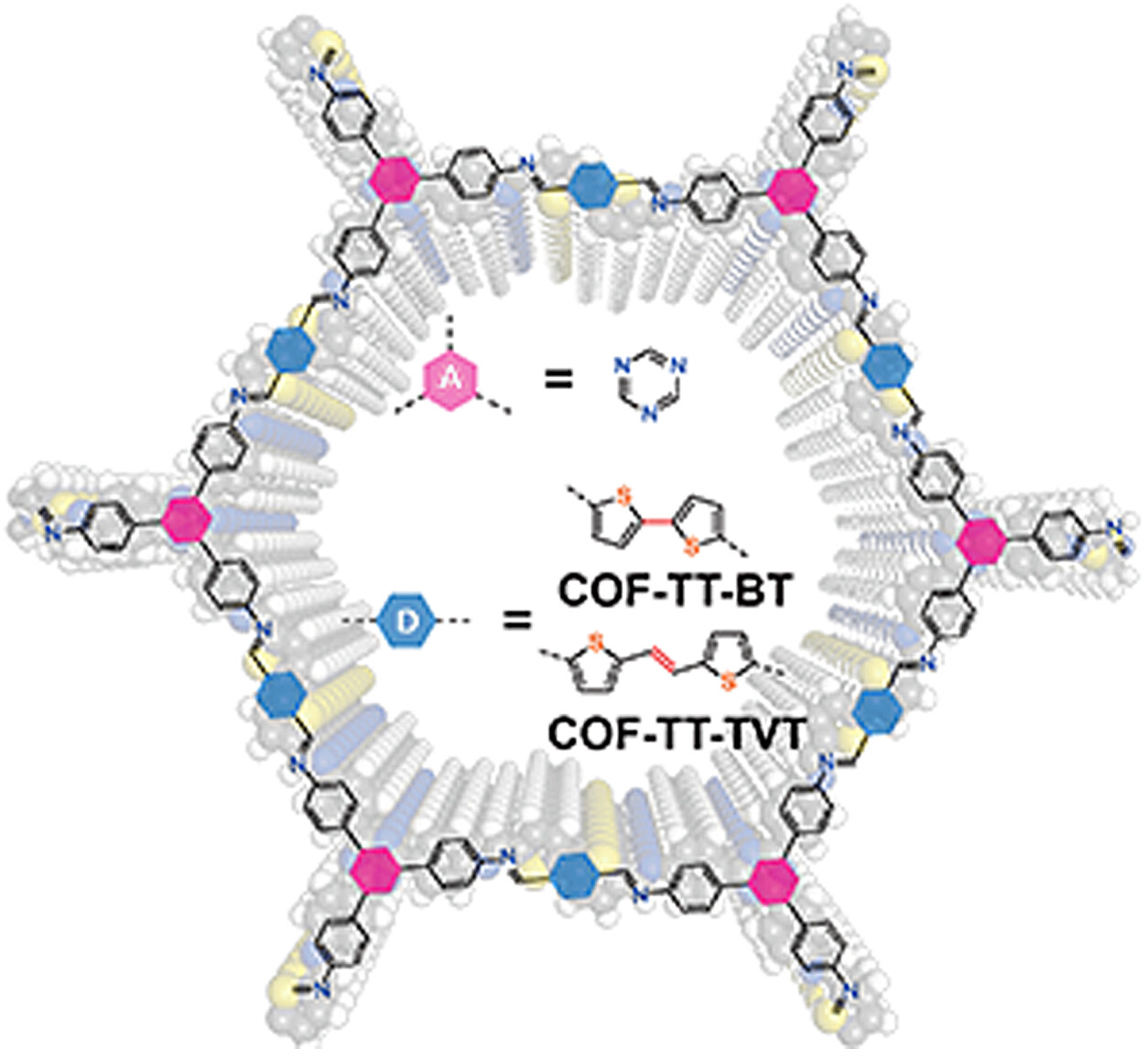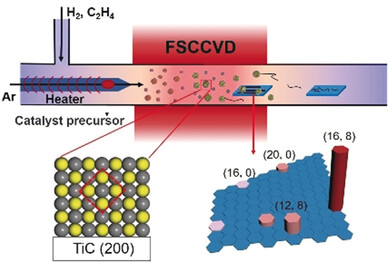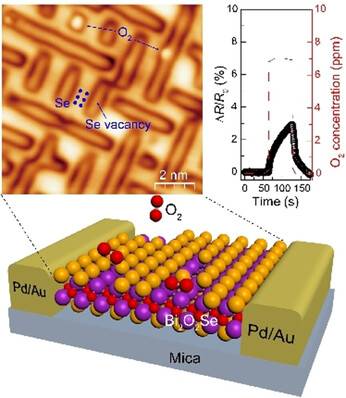Journal list menu
Export Citations
Download PDFs
Articles
Importance of the Relationship between Surface Phases and Photocatalytic Activity of TiO2†
- First Published: 11 February 2008

The junction boosts the function: With a combination of surface-sensitive techniques, the photocatalytic activity of TiO2 was found to be directly related to the surface-phase structure, and can be greatly enhanced when anatase TiO2 nanoparticles are highly dispersed on the surface of rutile TiO2 to form anatase–rutile surface-phase junctions (see picture for calcination progression).
Chiral Nanoscale Metal–Organic Tetrahedral Cages: Diastereoselective Self-Assembly and Enantioselective Separation†
- First Published: 26 May 2010

Cage rage: Chiral tetrahedral cages are diastereoselectively self-assembled from enantiopure C2-symmetric biphenyl bis(β-diketonate) linkers and C3-symmetric octahedral Fe3+ or Ga3+ ions (see picture; Fe purple, C blue, O red; cavity shown as an orange sphere). The porous polyhedra exhibit metal-dependent chiroptical behavior and act as hosts for the crystallization separation of racemic alcohols with up to 99.5 % ee.
Towards High-Performance Resistive Switching Behavior through Embedding a D-A System into 2D Imine-Linked Covalent Organic Frameworks
- First Published: 29 September 2021

Two D-A-type covalent organic frameworks have been designed and prepared following a novel strategy for the construction of endurable and reliable memory devices. The state-of-the-art memristor-based COF-TT-BT thin film showed typical rewritable resistive switching behavior, a high ON/OFF current ratio (ca. 105), good endurance of 319 cycles, and a long retention time of 3.3×104 s.
Growth of Single-Walled Carbon Nanotubes with Controlled Structure: Floating Carbide Solid Catalysts
- First Published: 20 March 2020

Floating catalysts: A rational approach for preparing a floating carbide solid catalyst (FSC) for the controlled growth of single-walled carbon nanotubes (SWNTs) was developed. Titanium carbide nanoparticle catalysts were obtained in the gas phase and chiral SWNTs with fourfold symmetry were grown thermodynamically from the (2 0 0) plane of titanium carbide. The sample contained an abundance of (16,8) tubes with about a 74 % content.
Exploiting Two-Dimensional Bi2O2Se for Trace Oxygen Detection
- First Published: 09 July 2020

2D single-crystal Bi2O2Se nanoplates show a unique surficial amorphous Se atomic layer and an improved specific surface area for efficient adsorption and detection of trace oxygen. 2D Bi2O2Se-based oxygen sensor presents ultrahigh sensitivity of 0.25 ppm detection minimum, wide-range response, strong selectivity, good stability, and high durativity at room temperature.
Cyano-Bridged 4f–3d Coordination Polymers with a Unique Two-Dimensional Topological Architecture and Unusual Magnetic Behavior
- First Published: 19 January 2001

Rings of 24 atoms form part of the two-dimensional structure of the novel compounds [NdM(bpym)(H2O)4(CN)6]⋅3 H2O (M = Fe (1), Co (2); bpym = 2,2′-bipyrimidine). These compounds are the first two-dimensional cyano-bridged species containing lanthanide and transition metal centers (see picture). The structures and magnetic properties are investigated.
Novel, Acentric Metal–Organic Coordination Polymers from Hydrothermal Reactions Involving In Situ Ligand Synthesis†
- First Published: 18 October 2002

The pyridyltetrazolate ligand formed in situ from NaN3 and 3-cyanopyridine in the presence of ZnCl2 or CdCl2 in water affords acentric (1) or chiral (2) coordination polymers, respectively. The corresponding reaction of ZnCl2 with 4-cyanopyridine gives acentric 3 (not shown). Compounds 1–3 are second harmonic generation active.
A Nanotubular 3D Coordination Polymer Based on a 3d–4f Heterometallic Assembly†
- First Published: 21 February 2003

Large pores comprising 48-membered rings characterize the isostructural lanthanide–transition-metal coordination polymers [{[Ln(dipic)3Mn1.5(H2O)3]⋅n H2O}∞], H2dipic=pyridine-2,6-dicarboxylic acid; Ln=Pr, n=2 (shown here); Ln=Gd, n=3.5; Ln=Er, n=3. Many water molecules are trapped in the nanotubular structure, and the framework remains intact on removal of the uncoordinated water molecules.
A Highly Luminescent Europium Complex Showing Visible-Light-Sensitized Red Emission: Direct Observation of the Singlet Pathway†
- First Published: 22 September 2004

Red glow in daylight …︁ chemist's delight! An efficient transfer of excitation energy from the ligand to the luminescent states of the coordinated EuIII ion in 1 occurs from the singlet excited state of the ligand. The complex shows characteristic bright red Eu-centered emission with a quantum yield of 0.52 when sensitized with visible light.
Reversible Switching between Superhydrophilicity and Superhydrophobicity†
- First Published: 29 December 2003
Is Mayenite without Clathrated Oxygen an Inorganic Electride?†
- First Published: 01 December 2004

Yes or no? Mayenite without the clathrated oxygen can be classified as an inorganic electride based on combined charge-density (see picture, A) and electron-localization-function (ELF) analysis (B). Ionic chemical bonds are found to form between extra electrons and the positively charged crystal framework in this material.
Single-Crystalline Iron Oxide Nanotubes†
- First Published: 04 July 2005

Phosphate ions play a crucial role not only for the formation of the spindlelike precursors of the single-crystalline hematite nanotubes that were synthesized by a facile hydrothermal method. They are also important for the adsorption and coordination effects. The mechanism of tube formation was deduced through EM observations as a coordination-assisted dissolution process (see picture).
Self-Assembled Vanadium Pentoxide (V2O5) Hollow Microspheres from Nanorods and Their Application in Lithium-Ion Batteries†
- First Published: 04 July 2005

“Hedgehog” or “nest” microspheres of V2O5 are formed when nanorods of V2O5 are synthesized in a mediated polyol process. When the concentration of the starting material is low, a nest shape is preferred, whereas a high concentration of [V(acac)3] affords hedgehog-shaped microspheres (see picture). The V2O5 microspheres exhibit remarkable electrochemical properties when used as the cathode material in a lithium-ion battery.
A Germanate Framework Containing 24-Ring Channels, NiGe Bonds, and Chiral [Ni@Ge14O24(OH)3] Cluster Motifs Transferred from Chiral Metal Complexes†
- First Published: 25 October 2005
Microporous: Chiral metal complexes as templates under solvothermal conditions resulted in two novel germanates Ni@Ge14O24(OH)3⋅2 Ni(L)3 (L=ethylenediamine, 1,2-diaminopropane). The chiral Ni@Ge14O24(OH)3 cluster motifs have an unprecedented trigonal-bipyramidal Ni@Ge5 core with NiGe bonds and are linked to each other to form a 3D germanate framework containing 24-ring channels (see picture).
Ordered Mesoporous Polymers and Homologous Carbon Frameworks: Amphiphilic Surfactant Templating and Direct Transformation†
- First Published: 31 October 2005
Ultrahigh stability (>1400 °C) is found for the highly ordered mesoporous polymers and carbon frameworks synthesized from polymerization of phenol and formaldehyde around triblock copolymer templates. Calcination and carbonization lead to removal of the templates and formation of hexagonal and cubic carbon mesostructures with large uniform pores and surface areas (see schematic diagram).
Ligand-Directed Strategy for Zeolite-Type Metal–Organic Frameworks: Zinc(II) Imidazolates with Unusual Zeolitic Topologies†
- First Published: 20 February 2006

Thermally robust porous metal–organic frameworks (MOFs) with zeolitic topologies were constructed by means of a ligand-directed strategy involving molecular tailoring of simple bridging imidazolates with coordinatively unimportant substituents. This led to the isolation of three new MOFs having unusually high symmetries, intriguing topologies such as the supercage shown in the picture, and high thermal stability.
Highly Asymmetric Michael Addition to α,β-Unsaturated Ketones Catalyzed by 9-Amino-9-deoxyepiquinine†
- First Published: 27 December 2006

Michael–Michael–retro-Michael cascade reactions are promoted by the highly efficient organocatalyst 9-amino-9-deoxyepiquinine (1). The asymmetric direct vinylogous Michael addition of α,α-dicyanoalkenes to α,β-unsaturated ketones may be followed by an intramolecular Michael addition and a retro-Michael reaction to afford polysubstituted 2-cyclohexen-1-one derivatives with high enantioselectivity (see example).
Halide Recognition by Tetraoxacalix[2]arene[2]triazine Receptors: Concurrent Noncovalent Halide–π and Lone-pair–π Interactions in Host–Halide–Water Ternary Complexes†
- First Published: 09 September 2008
![Halide Recognition by Tetraoxacalix[2]arene[2]triazine Receptors: Concurrent Noncovalent Halide–π and Lone-pair–π Interactions in Host–Halide–Water Ternary Complexes](/cms/asset/8ccceed2-c969-417a-b804-2a8d43322dd9/mcontent.jpg)
Cleft of center: The self fine-tuning π-deficient cleft of 1,3-dichloro-substituted tetraoxacalix[2]arene[2]triazine forms noncovalent π–halide and π–lone-pair-electron interactions with halides Cl− and Br−, and water, giving rise to ternary complexes in the solid state (see structure, N blue). In solution, the host molecule, formed by a different mechanism, complexes with fluoride, giving Ka (1:1) of over 4000 M−1.
Multiple CH Activations To Construct Biologically Active Molecules in a Process Completely Free of Organohalogen and Organometallic Components†
- First Published: 21 January 2008

Step by step: Highly selective cross dehydrogenative arylation of acetanilides was developed to construct biaryls under mild condition. With this method, different aryl CH bonds were activated in sequential reactions to construct functionalized carbazoles (see scheme), which are present as key structural units in various biological molecules and organic optical materials.
An N,N′-Dioxide/In(OTf)3 Catalyst for the Asymmetric Hetero-Diels–Alder Reaction Between Danishefsky's Dienes and Aldehydes: Application in the Total Synthesis of Triketide†
- First Published: 25 January 2008

In-teresting catalyst: An asymmetric hetero Diels–Alder reaction between Danishefsky's dienes and various aldehydes using an N,N′-dioxide/In(OTf)3 complex affords highly substituted chiral dihydropyranones with up to 99 % ee (see scheme). The catalyst was applied to the synthesis of triketide from propionaldehyde in 72 % yield and with 97 % ee.








































